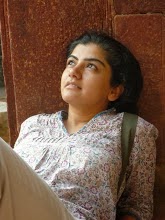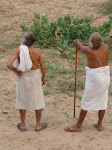I have wondered if Banaras is the only place in India that has a tireless energy to celebrate every festival on the Hindu calendar, and those of every other religion as well. A day after Diwali on the Gujarati New Year's day, I bought a calendar from the famous Kachori Gali of Banaras. This calendar, printed in the lane nearby, featured countless festivals and auspicious days, a few of which I bet are entirely unheard of in the north (Yet this is the north, isn't it?). Ever since I moved into the city (in the holiest month of Kartik), every day is a celebration. It started with Diwali, Naag Nathaiya, Annakut, Govardhan Puja, Ahoi , Ganesh Chaturthi, Dev Dipawali, Kartik Purnima, Dattatreya Jayanti, Ambedkar Jayanti. These kartik festivals were followed by Falgun and Chaitra festivals of Basant Panchami, Mauni Amavasya, Holi, Burhva Mangal, Gulab bari, Sankat Mochan Festival, Tulsi Ghat festival, Mahavir Jatanti, Shitala Ashtami, Mauni and Aamla Ekadashi. There also auspicious events and festivities related to wish-fulfillment like Manauti when you garland the river breadth-wise after your wish has been fulfilled and the 'Burfi and Gulab Jamun offering' day to the Ganga.
Mauharram in Banaras is quite unlike anywhere else. I had before seen processions with colourful Tazias and the emblems of the Shia faith near Lodi Colony in Delhi. But watching a group of Shiite mourners (young men) every night for a month in a state of near frenzy beat their chests to a highly charged pitch was a different experience. On the night before Moharram the previously 'missing-in-action' older Muslim men and women of the neighbourhood came out of their homes to get a glimpse of the 'dulha' as they all called him. On the eve of Ashura, I decided to wade through a large crowd of men and women to see what they were there to see. A man clearly not in his true senses was being escorted (read pulled in all directions) by young men. He was wearing white trousers and a button-down shirt that revealed his sweaty chest. The crowd then proceeded to a room with an ante-chamber where I stood with my bunch of burqa clad women. At this rather modest looking house, the dulha pays his respect to an enshrined horse-shoe that is believed to be of the horse from Karbala. After this quick but intense ceremony, the dulha and his gang of boys get ready for the action involving jumping on coal, on fire. The procession started from Shivala and then went around almost every neighbourhood in Banaras. The procession would end sometime in the morning and when a next set of mourners replaces them. During Moharram several canopied daises mushroom in the neighbourhoods like Madan Pura, Shivala in south Banaras . Old and young men gather together in the evening for an event of sorts. Stories, poems and a recital called the soz is performed all in remembrance of the martyrdom that took place in 7th century at Karbala. These anjumans outside of the chief Muslim mohallas are set up on the main road to Dashashwamedh. They may block the road for the passerby but the members of the anjuman are not unwelcoming to those interested in sharing the experience. Interestingly many more police men are seen during this time of the year than other. The policemen all sit outside a chai stall and gossip with their colleagues or with other customers at the chaiwala's. The nights pass peacefully but it is early in the morning that Mrs. Yadav's son plays 'Hare Ram Hare Ram' that I loose my sleep.
Missed this year: Shehnai players of the Khan family with the procession, the burial of the tazias we saw on display.
Banaras's mohallas and communities trying to compete with each other to celebrate better is a major reason for such exuberance. These sporting events between neighbourhoods, temples, communities and priests has helped in retaining the banarasi masti. And how else does one continue to have masti in a life without potable drinking water, medical facilities, electricity, roads, proper governance- they close their eyes and enjoy.
Monday, March 24, 2008
Subscribe to:
Post Comments (Atom)


No comments:
Post a Comment